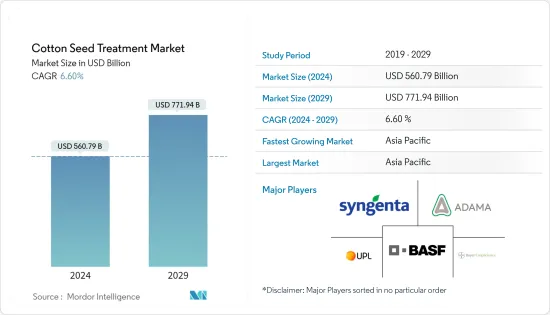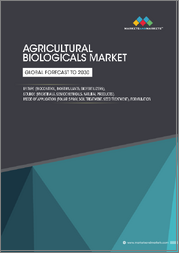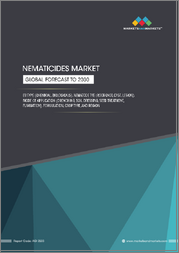
|
시장보고서
상품코드
1432875
면실 처리 : 시장 점유율 분석, 산업 동향 및 통계, 성장 예측(2024-2029년)Cotton Seed Treatment - Market Share Analysis, Industry Trends & Statistics, Growth Forecasts (2024 - 2029) |
||||||
면실 처리 시장 규모는 2024년 5,607억 9,000만 달러로 추정되며 2029년까지 7,719억 4,000만 달러에 달할 것으로 예상되며, 예측 기간(2024-2029년) 동안 6.60%의 CAGR로 성장할 것으로 예상됩니다.

주요 하이라이트
- 지난 10년 동안 유전자 변형 면화 교잡종 채택에 극적인 변화가 있었습니다. 2018년 미국은 506만 헥타르의 GM 면화를 심었습니다. 인도에서는 면화 면적의 거의 92%가 GM 면화를 재배하고 있습니다. GM 면화의 보급으로 상업 분야에서 면실 처리 제품의 사용량이 증가했습니다.
- 살균제는 면화에 사용되는 종자 처리 제품의 주요 범주입니다. 면화 묘목에 영향을 미치는 주요 곰팡이 병원균에는 리조크토니아, 페니실리움, 피시움, 푸사리움 등이 포함됩니다.
면실 처리 시장 동향
높은 효능이 살균제 부문 성장으로 이어질 것
면화 초기 단계의 곰팡이병은 종자 처리를 통해 쉽게 방제할 수 있습니다. 초기 단계의 목화에서 방제할 수 있는 주요 곰팡이 병원균에는 푸사리움, 리조크토니아, 헬민트스포리움, 피시움, 피토프트라, 티에라비옵시스 등이 있습니다. 곤충은 면화 작물에 가장 큰 피해를 주는 해충이지만, 작물 초기 단계의 곰팡이 병은 종자 처리를 통해 더 효과적으로 제어할 수 있는 것으로 나타났습니다. 면화 종자 처리에 사용되는 가장 일반적인 살균제에는 아족시스트로빈, 디페노코나졸, 플루디옥소닐, 메탈락실, 마이크로부타닐 등이 있습니다. 이러한 살균제는 주로 여러 병원균을 광범위하게 제어하기 위해 조합하여 사용됩니다. 살균 종자 처리 제품의 효능이 향상됨에 따라 면화 종자 처리 시장의 살균제 부문이 시장을 주도할 것으로 예상됩니다.
아시아태평양이 세계 시장을 주도
인도, 중국, 파키스탄은 아시아태평양에서 대부분의 면화를 재배하는 국가입니다. 인도는 1,220만 헥타르 이상의 면화를 재배하고 있습니다. 2014년까지 인도는 유전자 변형 면화 보급률이 92%에 달했습니다. 이로써 인도는 세계 최대의 면화 생산국이자 원면 수출국이 되었습니다. GM 면화의 채택은 또한 면화 상업용 종자 가공 분야가 검토 기간 동안 엄청난 성장을 이루었음을 의미합니다. 아시아태평양 시장은 대규모 다국적 기업뿐만 아니라 시장에서 활동하는 소규모 지역 기업의 존재가 특징입니다. 이 지역 시장의 상업적 분야에서 활동하는 기업들은 작물의 첫 15-20일 동안 목화에 기생하는 거의 모든 병원균과 해충을 광범위하게 방제할 수 있는 제품 조합을 종자 회사에 제공하는 데 점점 더 중점을 두고 있습니다.
면실 처리 산업 개요
면실 처리 시장은 고도로 통합되어 있으며, 세계 주요 기업들이 시장 점유율을 크게 차지하고 있습니다. 이들 기업의 시장 점유율 확대는 고도로 다각화된 제품 포트폴리오와 다수의 인수 및 계약에 기인하는 것으로 보입니다. 또한, 이들 기업은 연구개발, 제품 포트폴리오 확장, 광범위한 지리적 입지, 적극적인 인수 전략에 집중하고 있습니다. 주요 기업으로는 BASF SE, Syngenta AG, Adama Agriculture Solutions, UPL Limited, Bayer Crop Science AG 등이 있습니다.
기타 혜택
- 엑셀 형식의 시장 예측(ME) 시트
- 3개월간 애널리스트 지원
목차
제1장 서론
- 조사 가정과 시장 정의
- 조사 범위
제2장 조사 방법
제3장 주요 요약
제4장 시장 역학
- 시장 개요
- 시장 성장 촉진요인
- 시장 성장 억제요인
- Porter's Five Forces 분석
- 공급 기업의 교섭력
- 구매자의 교섭력
- 신규 참여업체의 위협
- 대체품의 위협
- 경쟁 기업 간의 경쟁 강도
제5장 시장 세분화
- 화학적 기원
- 합성
- 생물 유래
- 제품 유형
- 살충제
- 살균제
- 기타 제품 유형
- 용도
- 농장
- 상업용
- 지역
- 북미
- 미국
- 캐나다
- 멕시코
- 기타 북미
- 유럽
- 독일
- 영국
- 프랑스
- 스페인
- 러시아
- 이탈리아
- 기타 유럽
- 아시아태평양
- 중국
- 인도
- 일본
- 호주
- 기타 아시아태평양
- 남미
- 브라질
- 아르헨티나
- 기타 남미
- 아프리카
- 남아프리카공화국
- 기타 아프리카
- 북미
제6장 경쟁 상황
- 가장 많이 채용되고 있는 전략
- 시장 점유율 분석
- 기업 개요
- BASF SE
- Bayer Crop Science AG
- Syngenta AG
- Adama Agricultural Solutions
- UPL Limited
- Advanced Biological Marketing Inc.
- Corteva Agriscience
- Incotec Group BV
- Valent USA Corporation
제7장 시장 기회와 향후 동향
KSM 24.03.07The Cotton Seed Treatment Market size is estimated at USD 560.79 billion in 2024, and is expected to reach USD 771.94 billion by 2029, growing at a CAGR of 6.60% during the forecast period (2024-2029).

Key Highlights
- The last decade has witnessed a dramatic shift in the adoption of genetically modified cotton hybrids. In 2018, the United States planted 5.06 million hectares of GM cotton. In India, almost 92% of the cotton area cultivates GM cotton. The widespread adoption of GM cotton has resulted in increased usage of cotton seed treatment products in the commercial segment.
- Fungicides are the major category of seed treatment products used in cotton. The major fungal pathogens affecting young cotton plants include Rhizoctonia spp., Penicillium spp., Pythium spp., and Fusarium spp., among others.
Cotton Seed Treatment Market Trends
Higher Efficacy Leading to Growth of the Fungicides Segment
Early-stage fungal diseases in cotton can easily be controlled using seed treatment. The major fungal pathogens that can be controlled in early-stage cotton include Fusarium, Rhizoctonia, Helminthosporium, Pythium, Phytophthora, and Thielaviopsis. Although insects are the most damaging pests to cotton crop, fungal diseases at the early stages of the crop have found greater control through seed treatment. Some of the most popular fungicides used in the seed treatment of cotton are Azoxystrobin, Difenoconazole, Fludioxonil, Metalaxyl, and Myclobutanil, among others. These fungicides are used mostly in combinations to provide broad-spectrum control to more than one pathogen. The increased efficacy of fungicidal seed treatment products is expected to drive the market for the fungicide segment of the cotton seed treatment market.
Asia-Pacific Leads the Global Market
India, China, and Pakistan are the countries that cultivate a majority of cotton in the Asia-Pacific region. Cotton is grown over 12.2 million hectares in India. By the year 2014, India had achieved almost 92% penetration of genetically modified cotton. This has led to India being the top cotton producer and raw cotton exporter in the world. The adoption of GM cotton also means that the segment of commercial seed treatment in cotton has grown phenomenally over the review period. The Asia-Pacific market is characterized by the presence of large multinationals as well as smaller regional players active in the market. Companies active in the commercial segment of the market in the region are increasingly focusing on providing seed companies with product combinations, which provide broad spectrum control to almost all the pathogens and pests that infest cotton for the first 15-20 days of the crop.
Cotton Seed Treatment Industry Overview
The cotton seed treatment market is highly consolidated, with the top global players occupying large shares in the market. The greater market shares of these players can be attributed to highly diversified product portfolio and numerous acquisitions and agreements. Moreover, these players are focusing on R&D, expansion of product portfolio, wide geographical presence, and aggressive acquisition strategies. Some of the key players in the market include BASF SE, Syngenta AG, Adama Agricultural Solutions, UPL Limited, and Bayer Crop Science AG.
Additional Benefits:
- The market estimate (ME) sheet in Excel format
- 3 months of analyst support
TABLE OF CONTENTS
1 INTRODUCTION
- 1.1 Study Assumptions and Market Definition
- 1.2 Scope of the Study
2 RESEARCH METHODOLOGY
3 EXECUTIVE SUMMARY
4 MARKET DYNAMICS
- 4.1 Market Overview
- 4.2 Market Drivers
- 4.3 Market Restraints
- 4.4 Porter's Five Forces Analysis
- 4.4.1 Bargaining Power of Suppliers
- 4.4.2 Bargaining Power of Buyers
- 4.4.3 Threat of New Entrants
- 4.4.4 Threat of Substitute Products
- 4.4.5 Intensity of Competitive Rivalry
5 MARKET SEGMENTATION
- 5.1 Chemical Origin
- 5.1.1 Synthetic
- 5.1.2 Biological
- 5.2 Product Type
- 5.2.1 Insecticides
- 5.2.2 Fungicides
- 5.2.3 Other Product Types
- 5.3 Application
- 5.3.1 On-farm
- 5.3.2 Commerical
- 5.4 Geography
- 5.4.1 North America
- 5.4.1.1 United States
- 5.4.1.2 Canada
- 5.4.1.3 Mexico
- 5.4.1.4 Rest of North America
- 5.4.2 Europe
- 5.4.2.1 Germany
- 5.4.2.2 United Kingdom
- 5.4.2.3 France
- 5.4.2.4 Spain
- 5.4.2.5 Russia
- 5.4.2.6 Italy
- 5.4.2.7 Rest of Europe
- 5.4.3 Asia-Pacific
- 5.4.3.1 China
- 5.4.3.2 India
- 5.4.3.3 Japan
- 5.4.3.4 Australia
- 5.4.3.5 Rest of Asia-Pacific
- 5.4.4 South America
- 5.4.4.1 Brazil
- 5.4.4.2 Argentina
- 5.4.4.3 Rest of South America
- 5.4.5 Africa
- 5.4.5.1 South Africa
- 5.4.5.2 Rest of Africa
- 5.4.1 North America
6 COMPETITIVE LANDSCAPE
- 6.1 Most Adopted Strategies
- 6.2 Market Share Analysis
- 6.3 Company Profiles
- 6.3.1 BASF SE
- 6.3.2 Bayer Crop Science AG
- 6.3.3 Syngenta AG
- 6.3.4 Adama Agricultural Solutions
- 6.3.5 UPL Limited
- 6.3.6 Advanced Biological Marketing Inc.
- 6.3.7 Corteva Agriscience
- 6.3.8 Incotec Group BV
- 6.3.9 Valent USA Corporation



















